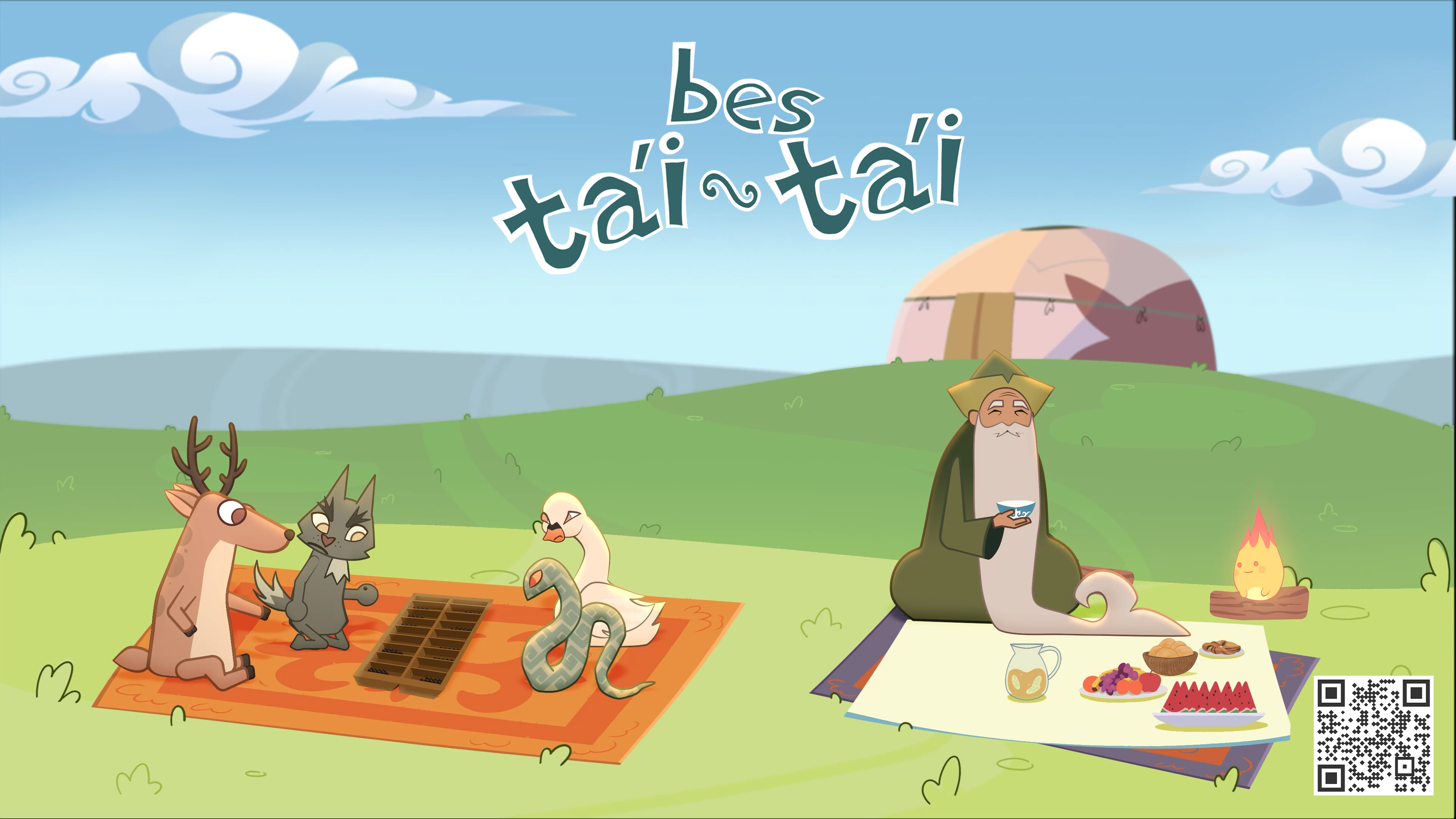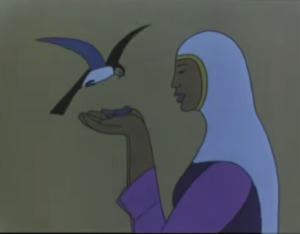ASTANA – Kazakhstan’s golden age in animation lies ahead despite challenges such as the lack of adequate funding and commercial unfeasibility, according to the founders of Tasqyn Animation Studio. They attribute its success solely to the enthusiasm and innovation of idea-driven creators. In an interview with the Astana Times, the studio managers share what the future holds for animated movies in Kazakhstan, the country’s talent pool and the costs of production.

Founders of Tasqyn studio: Yerkezhan Bekzhigitova, Aigerim Abdramanova and Madina Sutbayeva. Photo credit: Tasqyn studio press service
Founded in 2022, and managed by director Madina Sutbayeva, producer Aigerim Abdramanova and process manager Yerkezhan Bekzhigitova, Tasqyn studio has already made its name internationally. Last year, its “Seriktes” (Partner) animated noir film secured the Best Short Film award at the Animated Expressions Expo in France. With the recent success of “Seriktes” at the Santa Cruz International Film Festival in Argentina, winning in the Best Animated Film category, it would be all too easy to think Kazakh animation is thriving. But that is only part of the story.
Kazakhstan’s animation industry
“There are many studios in Kazakhstan, but due to certain circumstances, not many people know about them. Creating cartoons is not only a labor-intensive process but also costly. Therefore, some studios do crowd-funding, some choose to do commercial projects, while others rely solely on government subsidies,” said director Sutbayeva.

“Kunshikter” (Sunny-Puppies) cartoon by Tasqyn studion. Photo credit: Tasqyn studio’s press service
In the middle of this picture stands an animation film studio supported by large businesses as part of their Environmental, Social and Governance (ESG) strategy.
“That’s why our studio is one of the largest, as we managed to attract investment from businesses. At the same time, we have not yet reaped any financial rewards from our work because we work for the idea – we want to popularize quality content for children while ensuring that the quality of animation matches those of foreign counterparts,” added Sutbayeva.
The studio’s catalog includes six animation projects and two comics, “Adamtas” (Stoneman) and “Jastyq Shaq” (Youth), that are in progress. At the moment, the studio is producing and developing the second seasons of the animated series “Kunshikter” (Sunny-Puppies) and “Bes Tai-Tai” (Five Tai-Tais).
It is no cliche – animation studios in Kazakhstan struggle financially for their passions.
“Cartoons in Kazakhstan are not [commercially] successful, with many state-funded projects gathering dust on the shelves despite significant investment and years of development. Yes, the state allocates money for the creative industry, but the reality is that truly exceptional projects often require our independent funding efforts. Perhaps this is determined by the fact that young talents do not have enough connections at the beginning of their journey, and many do not know how to get subsidies. We may be wrong, but the independent pursuit of funding is much easier, although more energy-consuming,” said studio producer Abdramanova.

“Bes Tai-Tai” animated series narrates the story of a wise old man who sits by the riverbank and tells the forest animals old Kazakh fairy tales. Photo credit: Tasqyn studio’s press service
Young aspiring artists also struggle to turn their ideas and creative talents into rewarding careers, leading to a brain drain in the industry.
“At the moment, one of the major challenges in the field is that the existing specialists, unable to find sufficient funding at home, either export their work or relocate in search for better-paid opportunities abroad, which is hard to blame them for,” added Abdramanova.
Foreign cartoons still hold preference when it comes to long series with over 100 episodes.
“There is a demand among the viewers, yet local channels prioritize purchasing foreign content for profitability, overlooking projects like ours due to their limited episode count. Few episodes mean that there are not enough episodes to run for a whole year. We acknowledge that television channels sometimes have different goals compared to ours: they prioritize filling their schedules and generating revenue over working only for an idea,” said Abdramanova.
A positive trend is emerging as there is a growing demand for Kazakh-language content.
“The presence of content in the Kazakh market indicates existing demand. In addition, foreign Kazakh diasporas are reaching out to us more often seeking Kazakh-language content to ensure their children maintain a connection to their cultural identity,” said Abdramanova.

Still from a 1967 “Why is the Tail of the Swallow Split?” animation.
But with only 20 years of modern Kazakh animation, the industry is still evolving.
The history of Kazakh animation goes back to 1967, when the first domestic animated movie, “Why is the Tail of the Swallow Split?” by Kazakhstan’s pioneer animator Amen Khaidarov was released.
Abdramanova said it is her favourite classic cartoon created in Kazakhstan.
“It is a wonderful cartoon. The rendering of a popular fairy tale, dynamics, aesthetics – everything in it is wonderful, and the melody to indicate the flight of a mosquito is so memorable,” said Abdramanova.
The future of the Kazakh animation industry
So, where does Kazakh animation go from here? It appears that the future is in motion, with the popularity of cartoons that reflect the region’s rich history and culture.
Kazakhstan’s animation industry could find its own niche in the global market, given the country’s treasure trove of local mythology and folklore.
“The special feature of any animation is the story behind it, and the stories are based on the life experiences of the author. Everyone grows up surrounded by mentality, fairy tales, myths and the language they speak. This is the peculiarity of our animation, the stories that only Kazakhstan can tell,” said process manager Bekzhigitova.
The prime example is the animated series “Bes Tai-Tai,” which narrates the story of a wise old man who sits by the riverbank and tells the forest animals old Kazakh fairy tales.
“Kazakhstan has every chance to take its own path and popularize its cartoons, using what lies in the depths of our history and culture. The only thing that is needed is to present it in a modern way. For this, we need young professionals with progressive views,” said Bekzhigitova.
The new generation of students are coming from universities eager to test their skills in animation.
“Our country is full of talents: for several years now, two state universities in Astana and Almaty have been annually graduating animation film directors, so in this regard, everything is good in Kazakhstan,” she added.
At Tasqyn studio they dream of being the Kazakh alternative to foreign animation companies such as Dream Works or Ghibli Studio, building their own national narrative in animation.
“Cartoon Saloon, Tonko House, Petrick, Ghibli Studio, Pixar, Sony animation, Dream Works – this is a list of local studios and mastodons in the field. What they all have in common is, perhaps, commercial success in telling stories that touch people’s hearts. If we focus on local studios like Cartoon Saloon, they also strive to show the identity of their country in cartoons – they are also called the Irish answer to Disney. That’s basically what we’re aiming for. I advise everyone to increase their observance and sensitivity because the world of animation is beautiful,” said Bekzhigitova.
“The prospects are actually good. This includes an increased interest in the domestic product and the popularization [of Kazakh animation] in the world. The most important thing we can do on our part is not to stop; continue creating, even if it is unprofitable,” she added.

